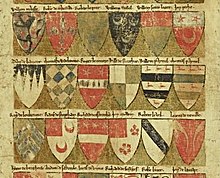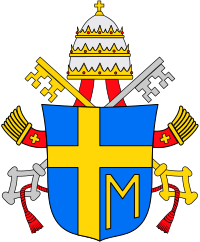Coat of arms
The coat of arms on an escutcheon forms the central element of the full heraldic achievement, which in its whole consists of a shield, supporters, a crest, and a motto.A coat of arms is traditionally unique to the armiger (e.g. an individual person, family, state, organization, school or corporation).The term "coat of arms" itself, describing in modern times just the heraldic design, originates from the description of the entire medieval chainmail "surcoat" garment used in combat or preparation for the latter.In the late medieval period, use of arms spread to the clergy, to towns as civic identifiers, and to royally chartered organizations such as universities and trading companies.The term coat of arms itself in origin refers to the surcoat with heraldic designs worn by combatants, especially in the knightly tournament, in Old French cote a armer.[4] Despite no common, enforceable widespread regulation,[citation needed] heraldry has remained consistent across Europe, where tradition alone has governed the design and use of arms.[5][citation needed] Some nations, such as England and Scotland, still maintain the same heraldic authorities which have traditionally granted and regulated arms for centuries and continue to do so in the present day.However, with the fall of the French monarchy (and later Empire) there is not currently a Fons Honorum (power to dispense and control honors) to strictly enforce heraldic law.Coats of arms in Spain were generally left up to the owner themselves, but the design was based on military service and the heritage of their grandparents.[10][11] The Great Seal of the United States uses on the obverse as its central motif a heraldic achievement described as being the arms of the nation.[12] The seal, and the armorial bearings, were adopted by the Continental Congress on 20 June 1782, and is a shield divided palewise into thirteen pieces, with a blue chief, which is displayed upon the breast of an American bald eagle.The crest is thirteen stars breaking through a glory and clouds, displayed with no helm, torse, or mantling (unlike most European precedents at the time).Symbols of a ritual significance according to local custom were generally favoured, such as the leopard in the arms of Benin, Malawi, Somalia, the Democratic Republic of the Congo and, in the form of the black panther, of Gabon.Japanese emblems, called kamon (often abbreviated "mon"), are family badges which often date back to the 7th century, and are used in Japan today.









Coat of Arms (Sabaton album)Coat of Arms (Wishbone Ash album)HeraldicachievementEscutcheon SupporterMantlingHelmetCompartmentChargesloganvisual designescutcheonshieldsurcoattabardheraldic achievementsupportersarmigerindividual personfamilyorganizationschoolcorporationRolls of armsearly Modern Agenoble familygenealogyHistory of heraldryList of oldest heraldryOrigin of the coat of armsDering Rollarmorialsocial conventionRichard IThird CrusadeBurgher armsHoly Roman Empirevexillologyknightly tournamentEnglandScotlandheraldic authoritiesCollege of ArmsemblemsblazontrademarksAlbert VII, Archduke of AustriaJacob FranquartHyghalmen RollFrench heraldryWestern EuropeanEnglish heraldryScottish heraldryWelsh heraldryDuke of Richmondwives and daughtersUndifferenced armsdifferenceRoyal Familyheir apparentheir presumptiveheraldsLord Lyon King of Armscriminal jurisdictionNorthern Irelandcivil lawHigh Court of ChivalryArthur Annesley, 1st Earl of AngleseyLord Privy SealEarl MarshalIrish heraldryRichard of York, 3rd Duke of YorkKing Edward IVIrelandUlster King of ArmsDublin CastleSir Nevile Rodwell WilkinsonThomas Ulick SadleirNorroy King of ArmsIreland King of ArmsKing Richard IIKing Henry VIIRepublic of IrelandGovernment of IrelandGenealogical OfficeChief Herald of IrelandBritish GovernmentNorroy and Ulster King of ArmsHouse of Burghprovince of UtrechtNetherlandsGerman heraldryNorwegian heraldrySwedish heraldryDanish heraldryFinnish heraldryIcelandic heraldryNordic countriesLiptovSlovakiaSpanish heraldryPortuguese heraldryHungarian heraldryDutch heraldryBelgian heraldryDenmarkSan MarinoSwitzerlandunificationConsulta AraldicaKingdom of ItalyFranceFleur-de-lysCanadian heraldrymonarch of Canada'sGovernor General of CanadaChief HeraldHerald ChancellorCanadian Heraldic AuthorityRideau HallUnited States heraldryGreat Seal of the United StatesContinental Congresstheir own coats of armsrespective state's seal

